| Revision as of 02:17, 25 August 2009 view sourceMm40 (talk | contribs)Autopatrolled, Extended confirmed users, Pending changes reviewers, Rollbackers10,258 editsm Cleanup/typo fixing using WP:AWB, typos fixed: Interupting → Interrupting using AWB← Previous edit | Revision as of 02:22, 25 August 2009 view source Gensanders (talk | contribs)1,207 editsm Correcting spelling: arrangment->arrangementNext edit → | ||
| Line 31: | Line 31: | ||
| ==Background== | ==Background== | ||
| Prior to 1815 the area now known as "Kashmir" was referred to as the "Panjab Hill States" and comprised 22 small independent states carved out of ] ] time to Afghan Amir / King ], who was Born in southern Punjab ] , Time Interrupting with a Brief Period of Muslim ] which also wanned after 1757. When the British East India Company Arrived Ending Mughal Influence, but Total Control was established after 1857 of British over India a which too after a Period of 100 Years. | Prior to 1815 the area now known as "Kashmir" was referred to as the "Panjab Hill States" and comprised 22 small independent states carved out of ] ] time to Afghan Amir / King ], who was Born in southern Punjab ] , Time Interrupting with a Brief Period of Muslim ] which also wanned after 1757. When the British East India Company Arrived Ending Mughal Influence, but Total Control was established after 1857 of British over India a which too after a Period of 100 Years. | ||
| These small states were ruled by ] who had sworn allegiance to the Mughal empire. In fact the Rajput of the Punjab Hill States were a major strength of the ] and had fought many battles in support of the Mughals especially against the Sikhs. Following the rise of the ] and the subsequent decline of the Mughal empire, the power of the Panjab Hill States also began to decline. They therefore became easy targets for the Sikh leader ] who proceeded to conquer these small states one by one. Eventually all the Panjab Hill States were conquered by Ranjit Singh and merged into one state to be called the State of Jammu. | These small states were ruled by ] who had sworn allegiance to the Mughal empire. In fact the Rajput of the Punjab Hill States were a major strength of the ] and had fought many battles in support of the Mughals especially against the Sikhs. Following the rise of the ] and the subsequent decline of the Mughal empire, the power of the Panjab Hill States also began to decline. They therefore became easy targets for the Sikh leader ] who proceeded to conquer these small states one by one. Eventually all the Panjab Hill States were conquered by Ranjit Singh and merged into one state to be called the State of Jammu. | ||
Revision as of 02:22, 25 August 2009
| Indo-Pakistani War of 1947 | |||||||||
|---|---|---|---|---|---|---|---|---|---|
| Part of the Indo-Pakistani Wars | |||||||||
| |||||||||
| Belligerents | |||||||||
|
India |
Pakistan | ||||||||
| Commanders and leaders | |||||||||
|
|
| ||||||||
| Casualties and losses | |||||||||
|
1,104 killed(Indian army) 684 killed (State Forces) 3,152 wounded |
1,500 killed (Pakistan army) | ||||||||
| Indo-Pakistani conflicts | |
|---|---|
| Kashmir conflict
Other conflicts Border skirmishes Strikes |
Template:Fixbunching The Indo-Pakistani War of 1947, sometimes known as the First Kashmir War, was fought between India and Pakistan over the region of Kashmir from 1947 to 1948. It was the first of four wars fought between the two newly independent nations. The result of the war still affects the geopolitics of both the countries.
Background
Prior to 1815 the area now known as "Kashmir" was referred to as the "Panjab Hill States" and comprised 22 small independent states carved out of Afghanistan [[Amir/ King controlled Terrotories combined with Local Small rulers . This Arrangement was from 900 AD from Sultan Mehmood Ghaznavi time to Afghan Amir / King Ahmed Shah Abdali, who was Born in southern Punjab Multan , Time Interrupting with a Brief Period of Muslim Mughal Empire which also wanned after 1757. When the British East India Company Arrived Ending Mughal Influence, but Total Control was established after 1857 of British over India a which too after a Period of 100 Years.
These small states were ruled by Rajput kings who had sworn allegiance to the Mughal empire. In fact the Rajput of the Punjab Hill States were a major strength of the Mughal empire and had fought many battles in support of the Mughals especially against the Sikhs. Following the rise of the British East India Company and the subsequent decline of the Mughal empire, the power of the Panjab Hill States also began to decline. They therefore became easy targets for the Sikh leader Ranjit Singh who proceeded to conquer these small states one by one. Eventually all the Panjab Hill States were conquered by Ranjit Singh and merged into one state to be called the State of Jammu.
History of Panjab castes by J. Hutchinson and J.P.Vogel lists a total of 22 states 16 Hindu and 6 Muhammadan that formed the State of Jammu following the conquest of Raja Ranjit Singh in 1820. Of these 6 Muhammadan States two (Kotli and Punch) were ruled by Mangrals, two (Bhimber and Khari-Khariyala) by Chibs one (Rajouri) by the Jarrals and one (Khashtwar) by the Khashtwaria.
The First Anglo-Sikh War was fought between the Sikh Empire, which asserted sovereignty over Kashmir, and the East India Company between 1845 and 1846. In the Treaty of Lahore in 1846, the Sikhs were made to surrender the valuable region (the Jullundur Doab) between the Beas River and Sutlej River and required to pay an indemnity of 1.2 million rupees.
Because they could not readily raise this sum, the East India Company allowed the Dogra ruler Gulab Singh to acquire Kashmir from the Sikh kingdom in exchange for making a payment of 750,000 rupees to the East India Company. Gulab Singh became the first Maharaja of the newly formed princely state of Jammu and Kashmir, founding a dynasty, The Royal House of Jammu and Kashmir, that was to rule the state, the second-largest principality during the British Raj, until India gained its independence in 1947.
Partition of India
See also: Kashmir conflictBefore and after the withdrawal of the British from India in 1947, the princely state of Kashmir and Jammu came under pressure from both India and Pakistan to agree to accede to one of the newly independent countries. According to the instruments of accession relating to the Partition of India, the rulers of princely states were to be given the choice of acceding to either India or Pakistan. The Maharaja of Kashmir, Hari Singh, however, wanted to remain an independent principality and tried to avoid accession to either country. When British forces withdrew the state was invaded by Pashtun tribals from the North West Frontier Province (NWFP).
Fearing that his forces would be unable to withstand the assault, the Maharaja asked for Indian military assistance. India set a condition that Kashmir must accede to India for it to receive assistance. Whereupon the Government of India recognized the accession of the erstwhile princely state to India, and was considered the new Indian state of Jammu and Kashmir, Indian troops were sent to the state to defend it against the Pakistani forces. The legitimacy of this accession is still disputed. Due to a lack of demographic data concerning religious affiliations, it is difficult to determine whether public opinion was a factor in Hari Singh's decision.
Pakistan was of the view that the Maharaja of Kashmir had no right to call in the Indian Army, because it held that the Maharaja of Kashmir was not a heredity ruler, that he was merely a British appointee. There had been no such position as the "Maharaja of Kashmir" prior to British rule. Hence Pakistan decided to take action, but British-appointed Army Chief of Pakistan Douglas Gracey did not send troops to the Kashmir front and refused to obey the order to do so given by Mohammad Ali Jinnah, Governor-General of Pakistan. Gracey's argument was that Indian forces occupying Kashmir represented the British Crown and hence he could not engage in a military encounter with Indian forces. Pakistan finally did manage to send troops to Kashmir but by then the Indian forces had taken control of approximately two thirds of the former principality.
Summary of war
The war was fought within the borders of the former princely state of Kashmir and Jammu by Indian Army, paramilitary and the erstwhile princely state forces opposed by Pakistan Army, paramilitary and local militias from the NWFP (the Pakistani forces referred to themselves as the Azad Kashmir forces (Azad in Urdu means liberated or free)). The princely state forces were unprepared for the initial assault of AZK forces, having been deployed thinly on the borders of the princely state for purposes of maintaining border security and deterring militant activity. The princely state defenses quickly collapsed in the face of the assault, some individuals and units joining the AZK forces.
The initial successes by AZK forces were not vigorously pressed, giving an opportunity for India to airlift its forces into Kashmir after the state had acceded to India.. With Indian reinforcements opposing AZK forces, the offensive ran out of steam towards the end of 1947, except in the High Himalayas sector where AZK forces made substantial progress until they were turned back at the outskirts of Leh in late June 1948. Throughout 1948 many small-scale battles were fought, but none gave a strategic advantage to either side and the fronts gradually solidified along what would became known as the Line of Control. A formal cease-fire was declared on 31 December 1948.
Stages of the war
This war has been split into ten stages by time. The individual stages are detailed below.
Initial invasion (Operation Gulmarg)
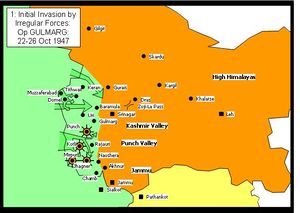
The objective of the initial invasion was to capture control of the Kashmir valley including its principal city, Srinagar, the summer capital of the state (Jammu being the winter capital). The state forces stationed in the border regions around Muzaffarabad and Domel were quickly defeated by AZK forces (some state forces mutinied and joined the AZK) and the way to the capital was open. Rather than advancing toward Srinagar before state forces could regroup or be reinforced, the invading forces remained in the captured cities in the border region engaging in looting and other crimes against their inhabitants. In the Punch valley, the state forces retreated into towns where they were besieged.

Indian defence of the Kashmir Valley
After the accession, India airlifted troops and equipment to Srinagar, where they reinforced the princely state forces, established a defense perimeter and defeated the AZK forces on the outskirts of the city. The successful defence included an outflanking manoeuvre by Indian armoured cars. The defeated AZK forces were pursued as far as Baramula and Uri and these towns were recaptured.
In the Punch valley, AZK forces continued to besiege state forces.
In Gilgit, the state paramilitary forces (the Gilgit Scouts) joined the invading AZK forces, who thereby obtained control of this northern region of the state. The AZK forces were also joined by troops from Chitral, whose ruler, the Mehtar of Chitral, had acceded to Pakistan.

Attempted link-up at Punch and fall of Mirpur
Indian forces ceased pursuit of AZK forces after recapturing Uri and Baramula, and sent a relief column southwards, in an attempt to relieve Punch. Although the relief column eventually reached Punch, the siege could not be lifted. A second relief column reached Kotli, but was forced to evacuate its garrison.
Meanwhile, Mirpur was captured by AZK forces on the 25th of November 1947. Then there was a massacre of Hindus and Sikhs and loot, and more later in Alibeg camp. Around 20 thousand people reported killed, also atrocities on women were reported.

Fall of Jhanger and attacks on Naoshera and Uri
The Pakistani/AZK forces attacked and captured Jhanger. They then attacked Naoshera unsuccessfully. Other Pakistani/AZK forces made a series of unsuccessful attacks on Uri. In the south a minor Indian attack secured Chamb. By this stage of the war the front line began to stabilise as more Indian troops became available.

Operation Vijay: counterattack to Jhanger
The Indian forces launched a counterattack in the south recapturing Jhanger and Rajauri. In the Kashmir Valley the Pakistani/AZK forces continued attacking the Uri garrison. In the north Skardu was brought under siege by Pakistani/AZK forces.
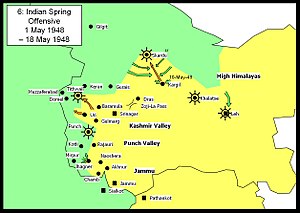
Indian Spring Offensive
The Indians held onto Jhanger against numerous counterattacks from the AZK, who were increasingly supported by regular Pakistani Forces. In the Kashmir Valley the Indians attacked, recapturing Tithwail. The AZK made good progress in the High Himalayas sector, infiltrating troops to bring Leh under siege, capturing Kargil and defeating a relief column heading for Skardu.
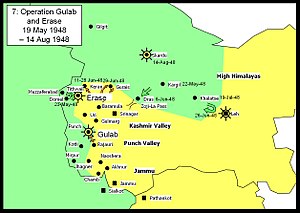
Operations Gulab and Erase
The Indians continued to attack in the Kashmir Valley sector driving north to capture Keran and Gurais. They also repelled a counterattack aimed at Tithwail. In the Punch Valley the forces besieged in Punch broke out and temporarily linked up with the outside world again. The Kashmir State army was able to defend Skardu from the Gilgit Scouts and thus they were not able to proceed down the Indus valley towards Leh. In August the Chitral Forces under Mata-ul-Mulk besieged Skardu and with the help of artillery were able to take Skardu. This freed the Gilgit Scouts to push further into Ladakh.
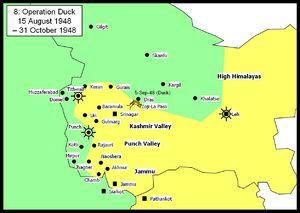
Operation Duck
During this time the front began to settle down with less activity by either side, the only major event was an unsuccessful attack by the Indians towards Dras (Operation Duck). The siege of Punch continued.

Operation Easy; Punch link-up
The Indians now started to get the upper hand in all sectors. Punch was finally relieved after a siege of over a year. The Gilgit forces in the High Himalayas, who had previously made good progress, were finally defeated. The Indians pursued as far as Kargil before being forced to halt due to supply problems. The Zoji-La pass was forced by using tanks (which had not been thought possible at that altitude) and Dras was recaptured. The use of tanks was based on experience gained in Burma in 1945.
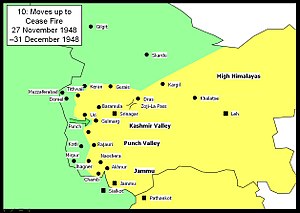
Moves up to cease-fire
At this stage Indian Prime Minister Jawahar Lal Nehru decided to ask UN to intervene. A UN cease-fire was arranged for the 31 December 1948. A few days before the cease-fire the Pakistanis launched a counter attack, which cut the road between Uri and Punch. After protracted negotiations a cease-fire was agreed to by both countries, which came into effect. The terms of the cease-fire as laid out in the UNCIP resolution. of August 13 1948 were adopted by the UN on January 5 1949. This required Pakistan to withdraw its forces, both regular and irregular, while allowing India to maintain minimum strength of its forces in the state to preserve law and order. On compliance of these conditions a plebiscite was to be held to determine the future of the territory. In all, 1,500 soldiers died on each side during the war and Pakistan was able to acquire roughly two-fifths of Kashmir, including five of the fourteen eight thousanders plus peaks of the world, while India maintained the remaining three fifths of Kashmir, including the most populous and fertile regions.
Military insights gained from the war
On the use of armour
The use of light tanks and armoured cars was important at two stages of the war. Both of these Indian victories involved very small numbers of AFVs. These were:-
- The defeat of the initial thrust at Srinagar, which was aided by the arrival of 2 armoured cars in the rear of the irregular forces.
- The forcing of the Zoji-La pass with 11 Stuart M5 light tanks.
This may show that armour can have a significant psychological impact if it turns up at places thought of as impossible. It is also likely that the invaders did not deploy anti-tank weapons to counter these threats. Even the lightest weapons will significantly encumber leg infantry units, so they may well have been perceived as not worth the effort of carrying about, and left in rear areas. This will greatly enhance the psychological impact of the armour when it does appear. The successful use of armour in this campaign strongly influenced Indian tactics in the 1962 war where great efforts were made to deploy armour to inhospitable regions (although with much less success in that case).
Progression of front lines
- It is interesting to chart the progress of the front lines. After a certain troop density is reached progress was very slow with victories being counted in the capture of individual villages or peaks. Where troop density was lower (as it was in the High Himalayas sector and at the start of the war) rates of advance can be very high.
Deployment of forces
- The Jammu and Kashmir state forces were spread out in small packets along the frontier to deal with militant incidents. This made them very vulnerable to a conventional attack. India used this tactic successfully against the Pakistan Army in East Pakistan (present day Bangladesh) in the 1971 war.
See also
Notes
- ^ Official Government of India Statement giving numbers of KIA - Parliament of India Website. It is believed that this figure only gives the Indian Army casualties and not the State Forces.
- JAK Rifles KIA
- Indian Army-Martyrs Home Page
- Library of Congress Country Studies
- Battle Casualties of Azad Kashmir Regiment during 1947-1948
- History of the Panjab Hill States By J. Hutchinson, J.P. Vogel
- Srinagar www.collectbritain.co.uk.
- I Indo-Pakistani War, 1947-1949 By Tom Cooper Air Combat Information Group October 29, 2003
- Mirpur 1947- the Untold Story
- Kashmir, Storm Center of the World
- Resolution adopted by the United Nations Commission for India and Pakistan on 13 August 1948
- Global security
Bibliography
- Major sources
- Operations In Jammu and Kashmir 1947-1948, Ministry of Defence, Government of India, Thomson Press (India) Limited. New Delhi 1987. This is the Indian Official History.
- The Indian Army After Independence, by KC Praval, 1993. Lancer International, ISBN 1-897829-45-0
- Slender Was The Thread: The Kashmir confrontation 1947-1948, by Maj Gen LP Sen, 1969. Orient Longmans Ltd New Delhi.
- Without Baggage: A personal account of the Jammu and Kashmir Operations 1947-1949 Lt Gen. E. A. Vas. 1987. Natraj Publishers Dehradun. ISBN 81-85019-09-6.
- Kashmir: A Disputed Legacy, 1846-1990 by Alastair Lamb, 1991. Roxford Books. ISBN 0-907129-06-4.
- Other sources
- The Indian Armour: History Of The Indian Armoured Corps 1941-1971, by Maj Gen Gurcharn Sandu, 1987, Vision Books Private Limited, New Delhi, ISBN 81-7094-004-4.
- Thunder over Kashmir, by Lt Col Maurice Cohen. 1955 Orient Longman Ltd. Hyderabad
- Battle of Zoji La, by Brig Gen SR Hinds, Military Digest, New Delhi, 1962.
- History of Jammu and Kashmir Rifles (1820-1956), by Maj K Barhma Singh, Lancer International New Delhi, 1990, ISBN 81-7062-091-0.
| Military history of Pakistan | |||||
| Leadership |
| ||||
| Services |
| ||||
| Paramilitary | |||||
| Personnel |
| ||||
| Business interests |
| ||||
| Criticism | |||||
| History series | ||||||||||||||
|---|---|---|---|---|---|---|---|---|---|---|---|---|---|---|
| ||||||||||||||
